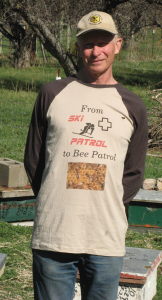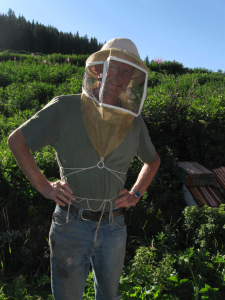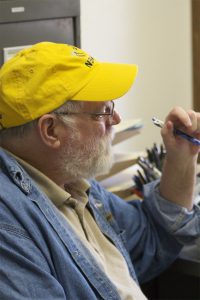by Ed Colby
My Aspen Mountain ski patrol boss Bud gave me my best job evaluation ever, maybe because this is my last  season. I got to write comments of my own at the end of the appraisal form. I have old-man handwriting. When Bud tried to read my chicken scratches, he looked bemused. “Does this say, ‘Thanks for loving me?’” he asked.
season. I got to write comments of my own at the end of the appraisal form. I have old-man handwriting. When Bud tried to read my chicken scratches, he looked bemused. “Does this say, ‘Thanks for loving me?’” he asked.
“No, Bud, I wrote, ‘Thanks for hiring me!”’
Then once I had him laughing, I went for the kill. “My bees are back from California,” I said. “I need the rest of the season off. I’ll be back for the end-of-season party.”
I had him on the ropes. What could he say? I was retiring, and the season was about over anyway. “I guess,” he muttered. “When would be your last day?”
“Today,” I said.
The California almonds were early this year, and my bees came back to Colorado before March 20. Oh, my! Top and bottom brood boxes mostly full of bees, honey, pollen and brood. Of the 59 colonies I sent, 57 came back alive.
I tested for Varroa mites and found a few, but no chalkbrood or American or European foulbrood.
I got the supers reversed, and I was mulling over just splitting hives and letting the bees make their own new queens. I didn’t want to go begging and borrowing queens from Paul. My two California suppliers had me scheduled for late April shipments. Then out of the blue Julie from Koehnen called to say they got a little ahead, and she could ship me 40 queens the week of April 5. Praise all the saints!
When I make splits, I just shake the bees from the top brood super into the bottom super, put on a queen excluder, and then replace the top super. The bees re-occupy the top super in short order, but of course the queen remains trapped in the bottom super. Now I can simply remove the top super and take it to a different location to introduce a new queen. A new location, because I don’t want foragers from both splits returning to only one.
To introduce a queen, I let the receiving hive go queenless for 24 hours. Then I put a caged new queen into the brood nest, with the candy plug in the cage exposed, so the worker bees can get at it. Then I walk away and stay away for a week or 10 days. I get 90 percent queen acceptance. There are more complicated ways to introduce queens, but this is my way.
The ski hill is a great place to meet folks, especially if you wear a name tag. The other day as I walked out of one of the mountain restaurants, an unfamiliar woman approached me. “You’re the beekeeper!” she exclaimed. She and I have a mutual friend, and he told her to look me up. She wants a top bar hive. She read a book about them. To me a top bar hive makes as much sense as driving a horse and buggy, but who am I to rain on her parade? I told her to sign up for Derrick’s Saturday beekeeping classes in Silt. And I told her Paul might sell her some bees. I suggested she get two hives, just in case. I tried to be encouraging, even though I knew she had no idea what she was getting into. I said, “Call me 24/7.”
When we talked on the phone, she told me she’d just ordered two top bar hives and signed up for a class in Steamboat taught by a “bee whistler.” I said, “I whistle all the time when I’m out there with my little darlings.” The woman didn’t say anything to that. Later my gal Marilyn explained that my new friend obviously said “bee whisperer,” because whisperers are all the rage. The woman fretted about all the things that beekeeping newcomers obsess over. Like hive location. She wanted me to walk her property and pick the perfect spot for her, like a dowser divining for water. She lives in a canyon with not a lot of sunlight. I said, “Find your sunniest spot and put your hives there. Just do it! You don’t need me.”
This poor child intends to buy a couple of nucs, shake the bees off brood, pollen and honey-filled comb, into an empty top bar hive. Now what? I gently suggested that in order to succeed at beekeeping, she might first have to fail, because it’s not all in books. I’m not sure she grasped that.
When I get a queen shipment, I generally pick them up at the UPS depot. Cheryl works there and acts like getting to hold honey bee queens for me is about the biggest honor anyone could bestow. She always reminds me that she waters the little darlings by sprinkling droplets of water on the ventilation screens. Bless her heart.
The UPS depot stays open late, so I stopped by after work to pick up my queens. That was last Wednesday, the day I got my patrol evaluation and finally retired.
Ed Colby practices beekeeping in Aspen Mountain, Colorado, where he lives with his partner, Marilyn.









